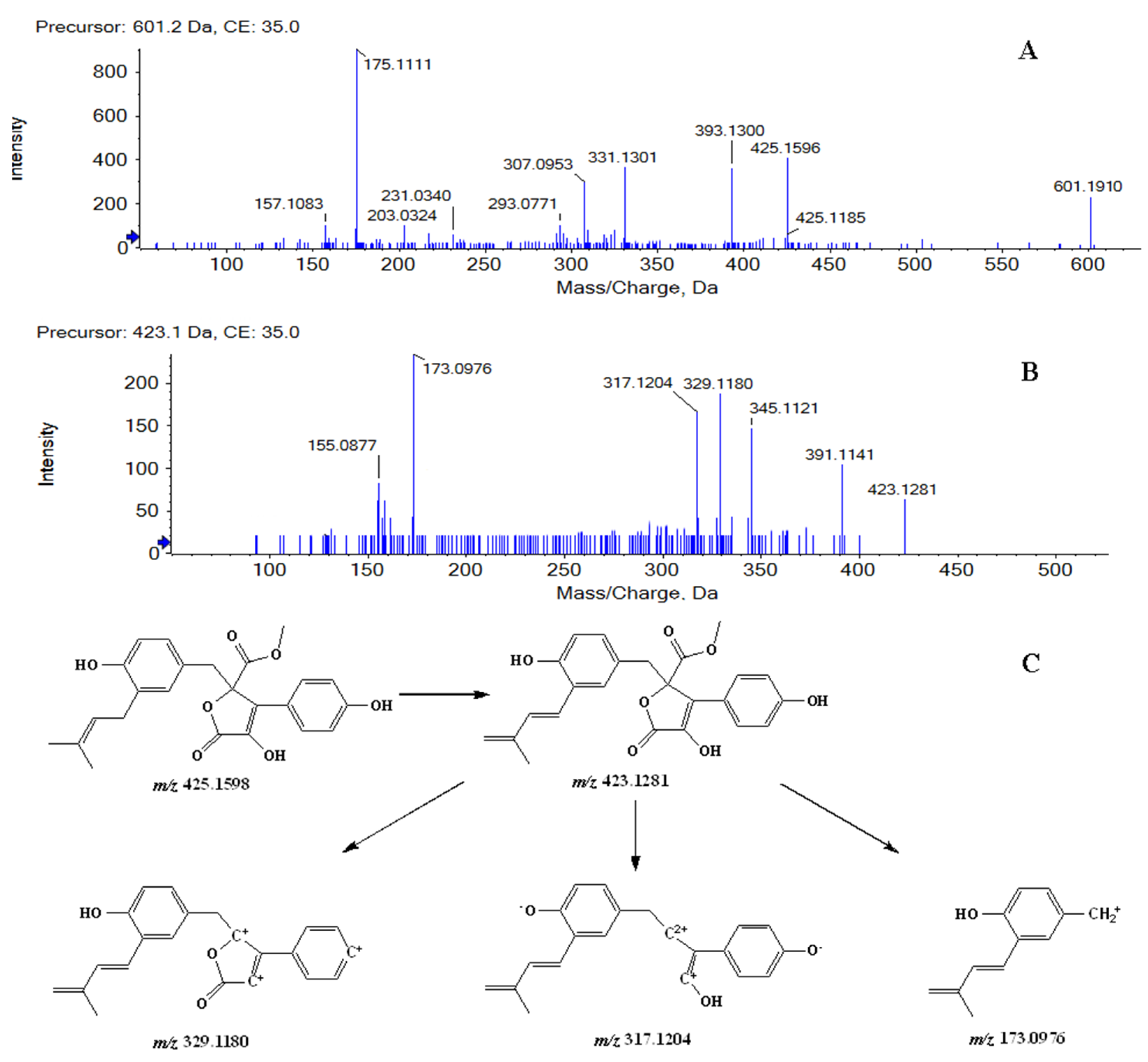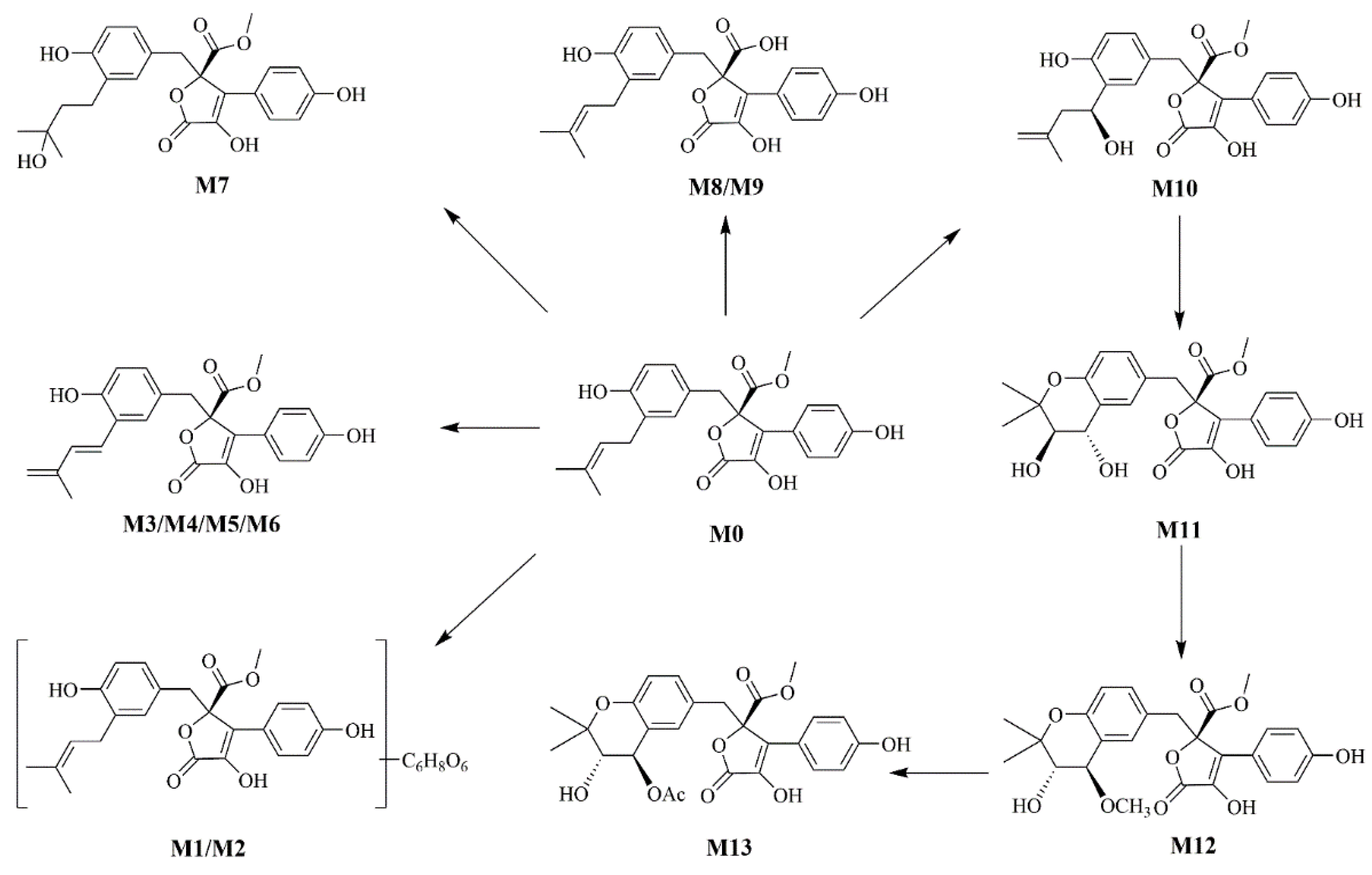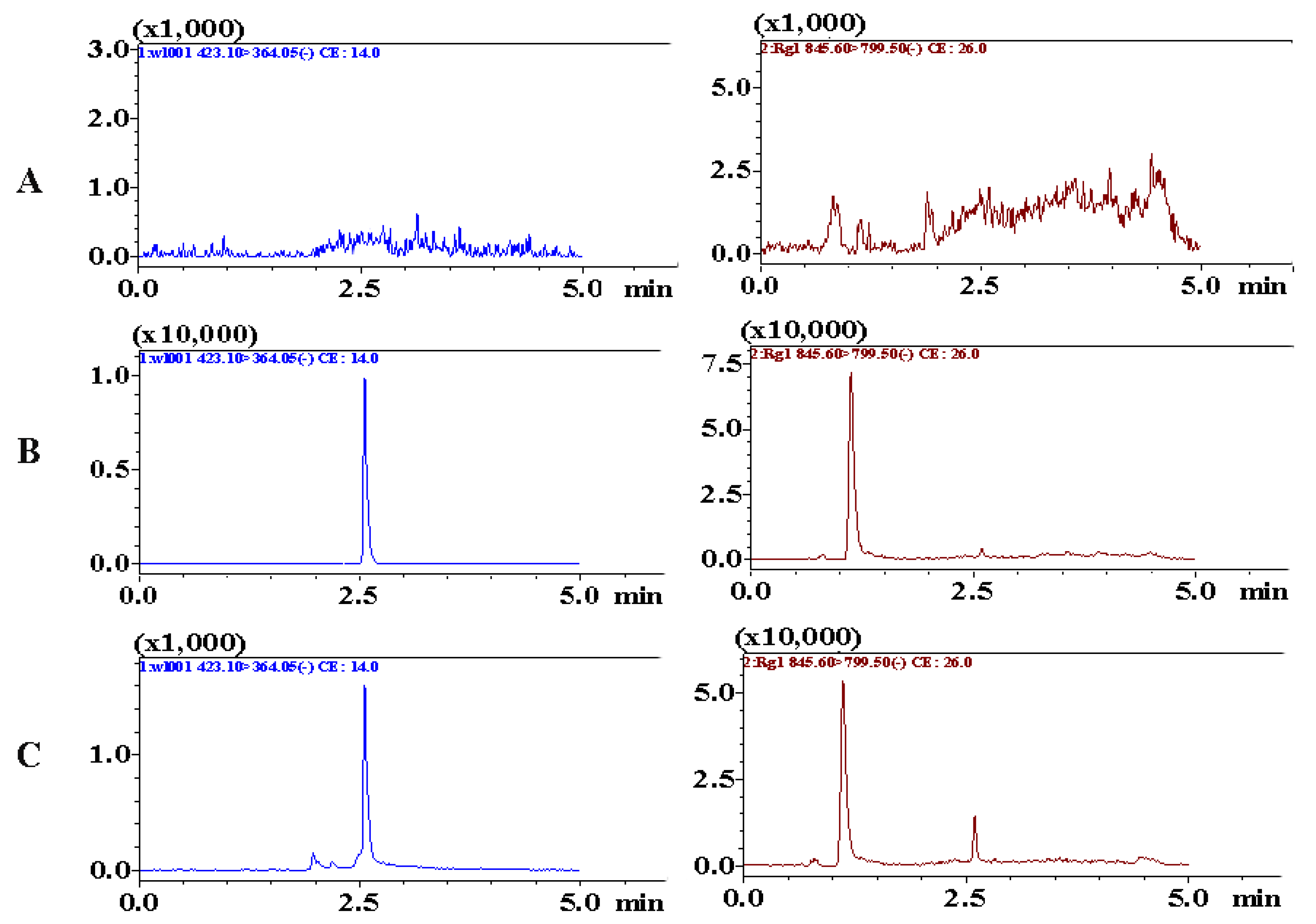Pharmacokinetics and Metabolism Study of Deep-Sea-Derived Butyrolactone I in Rats by UHPLC–MS/MS and UHPLC–Q-TOF-MS
Abstract
:1. Introduction
2. Results and Discussion
2.1. Metabolism Study of BTL in Rats
2.1.1. Fragmentation of BTL-I Standard
2.1.2. Analysis of BTL-I Metabolites
2.1.3. Metabolic Profiling of BTL-I in Rats
2.2. Pharmacokinetic Study
2.2.1. Method Development
2.2.2. Method Validation
2.2.3. Pharmacokinetic Study
3. Materials and Methods
3.1. Chemicals and Reagents
3.2. Animals, Drug Administration and Sampling
3.3. Sample Preparation
3.3.1. Sample Pretreatment
3.3.2. Preparation of Standard Curve and Quality Control (QC) Samples
3.4. Instrument and LC–MS Conditions
3.4.1. LC–MS/MS Condition
3.4.2. UHPLC–Q-TOF-MS Condition
3.5. Method Validation
3.5.1. Selectivity and Carry-Over Effect
3.5.2. Linearity and Lowest Limit of Quantitation (LLOQ)
3.5.3. Precision and Accuracy
3.5.4. Matrix Effect and Extraction Recovery
3.5.5. Stability
3.6. Data Analysis
4. Conclusions
Supplementary Materials
Author Contributions
Funding
Institutional Review Board Statement
Data Availability Statement
Conflicts of Interest
References
- Eggesbo, M.; Botten, G.; Halvorsen, R.; Magnus, P. The prevalence of allergy to egg: A population-based study in young children. Allergy 2001, 56, 403–411. [Google Scholar] [CrossRef] [PubMed]
- Bochner, B.S.; Rothenberg, M.E.; Boyce, J.A.; Finkelman, F. Advances in mechanisms of allergy and clinical immunology in 2012. J. Allergy Clin. Immunol. 2013, 131, 661–667. [Google Scholar] [CrossRef] [PubMed]
- Karam, M.; Scherzer, R.; Ogbogu, P.U.; Green, T.D.; Greenhawt, M. Food allergy prevalence, knowledge, and behavioral trends among college students—A 6-year comparison. J. Allergy Clin. Immunol. Pract. 2017, 5, 504–506. [Google Scholar] [CrossRef] [PubMed]
- Nwaru, B.I.; Hickstein, L.; Panesar, S.S.; Roberts, G.; Muraro, A.; Sheikh, A. Prevalence of common food allergies in Europe: A systematic review and meta-analysis. Allergy 2014, 69, 992–1007. [Google Scholar] [CrossRef] [PubMed]
- Freeland, D.M.H.; Manohar, M.; Andorf, S.; Hobson, B.D.; Zhang, W.; Nadeau, K.C. Oral immunotherapy for food allergy. Semin. Immunol. 2017, 30, 36–44. [Google Scholar] [CrossRef] [PubMed]
- Carroll, A.R.; Copp, B.R.; Davis, R.A.; Keyzers, R.A.; Prinsep, M.R. Marine natural products. Nat. Prod. Rep. 2021, 38, 362–413. [Google Scholar] [CrossRef] [PubMed]
- Reber, L.L.; Marichal, T.; Mukai, K.; Kita, Y.; Tokuoka, S.M.; Roers, A.; Hartmann, K.; Karasuyama, H.; Nadeau, K.C.; Tsai, M.; et al. Selective ablation of mast cells or basophils reduces peanut-induced anaphylaxis in mice. J. Allergy Clin. Immunol. 2013, 132, 881–888. [Google Scholar] [CrossRef] [PubMed] [Green Version]
- Gao, Y.Y.; Liu, Q.M.; Liu, B.; Xie, C.L.; Cao, M.J.; Yang, X.W.; Liu, G.M. Inhibitory activities of compounds from the marine actinomycete Williamsia sp. MCCC 1A11233 variant on IgE-mediated mast cells and passive cutaneous anaphylaxis. J. Agric. Food Chem. 2017, 65, 10749–10756. [Google Scholar] [CrossRef] [PubMed]
- Xing, C.P.; Chen, D.; Xie, C.L.; Liu, Q.; Zhong, T.H.; Shao, Z.; Liu, G.; Luo, L.Z.; Yang, X.W. Anti-food allergic compounds from Penicillium griseofulvum MCCC 3A00225, a deep-sea-derived fungus. Mar. Drugs 2021, 19, 224. [Google Scholar] [CrossRef] [PubMed]
- Kiriyama, N.; Nitta, K.; Sakaguchi, Y.; Taguchi, Y.; Yamamoto, Y. Studies on the metabolic products of Aspergillus terreus. III. Metabolites of the strain IFO 8835. (1). Chem. Pharm. Bull. 1977, 25, 2593–2601. [Google Scholar] [CrossRef] [Green Version]
- Zhang, Y.Y.; Zhang, Y.; Yao, Y.B.; Lei, X.L.; Qian, Z.J. Butyrolactone-I from coral-derived fungus Aspergillus terreus attenuates neuro-inflammatory response via suppression of NF-κB pathway in BV-2 cells. Mar. Drugs 2018, 16, 202. [Google Scholar] [CrossRef] [PubMed] [Green Version]
- Hosoi, T.; Uchiyama, M.; Okumura, E.; Saito, T.; Ishiguro, K.; Uchida, T.; Okuyama, A.; Kishimoto, T.; Hisanaga, S. Evidence for cdk5 as a major activity phosphorylating tau protein in porcine brain extract. J. Biochem. 1995, 117, 741–749. [Google Scholar] [CrossRef] [PubMed]
- Kitagawa, M.; Higashi, H.; Suzuki-Takahashi, I.; Segawa, K.; Hanks, S.K.; Taya, Y.; Nishimura, S.; Okuyama, A. Phosphorylation of E2F-1 by cyclin A-cdk2. Oncogene 1995, 10, 229–236. [Google Scholar] [PubMed]
- Liu, Q.M.; Xie, C.L.; Gao, Y.Y.; Liu, B.; Lin, W.X.; Liu, H.; Cao, M.J.; Su, W.J.; Yang, X.W.; Liu, G.M. Deep-sea-derived butyrolactone I suppresses ovalbumin-induced anaphylaxis by regulating mast cell function in a murine model. J. Agric. Food Chem. 2018, 66, 5581–5592. [Google Scholar] [CrossRef] [PubMed]
- Ahn, S.; Jang, D.M.; Park, S.C.; An, S.; Shin, J.; Han, B.W.; Noh, M. Cyclin-dependent kinase 5 inhibitor butyrolactone I elicits a partial agonist activity of peroxisome proliferator-activated receptor γ. Biomolecules 2020, 10, 275. [Google Scholar] [CrossRef] [PubMed] [Green Version]
- He, C.; Wan, H. Drug metabolism and metabolite safety assessment in drug discovery and development. Expert. Opin. Drug Metab. Toxicol. 2018, 14, 1071–1085. [Google Scholar] [CrossRef] [PubMed]
- Shikov, A.N.; Flisyuk, E.V.; Obluchinskaya, E.D.; Pozharitskaya, O.N. Pharmacokinetics of Marine-Derived Drugs. Mar. Drugs 2020, 18, 557. [Google Scholar] [CrossRef]
- An, X.; Feng, B.M.; Chen, G.; Chen, S.F.; Bai, J.; Hua, H.M.; Wang, H.F.; Pei, Y.H. Isolation and identification of phase I metabolites of butyrolactone I in rats. Xenobiotica 2017, 47, 236–244. [Google Scholar] [CrossRef] [PubMed]






| tR | Measured m/z | Calculated m/z | Formula | Product ions | Error (ppm) | Source | |
|---|---|---|---|---|---|---|---|
| M0 | 13.87 | 425.1598 | 425.1600 | C24H25O7 | 393.1306, 331.1369, 275.0701, 175.1124 | −0.5 | B F |
| M1 | 11.08 | 601.1906 | 601.1910 | C30H33O13 | 425.1596, 393.1300, 331.1301, 175.1111 | −0.7 | B U |
| M2 | 11.87 | 601.1906 | 601.1910 | C30H33O13 | 425.1606, 393.1301, 331.1334, 175.1115 | −0.7 | B |
| M3 | 8.42 | 423.1440 | 423.1444 | C24H23O7 | 391.1141, 345.1099, 329.1217, 317.1183, 173.0970 | −1.0 | B |
| M4 | 9.19 | 423.1440 | 423.1444 | C24H23O7 | 391.1141, 345.1121, 329.1180, 317.1204, 173.0976 | −1.0 | B |
| M5 | 10.82 | 423.1440 | 423.1444 | C24H23O7 | 345.1134, 329.1214, 275.0971, 173.0961 | −1.0 | F |
| M6 | 11.63 | 423.1440 | 423.1444 | C24H23O7 | 345.1134, 329.1214, 275.0971, 173.0961 | −1.0 | F |
| M7 | 11.17 | 443.1698 | 443.1706 | C24H27O8 | 349.0429 | −1.8 | F |
| M8 | 9.38 | 411.1443 | 411.1444 | C23H23O7 | 275.0743, 175.1098 | −0.2 | B |
| M9 | 11.71 | 411.1443 | 411.1444 | C23H23O7 | 393.1261, 331.1387, 275.0768, 175.1133 | −0.2 | B |
| M10 | 13.03 | 441.1525 | 441.1549 | C24H25O8 | 363.1112 | −5.4 | F |
| M11 | 11.96 | 457.1506 | 457.1498 | C24H25O9 | 363.1112 | 1.8 | F |
| Concentration (ng/mL) | Intra-Day | Inter-Day | ||
|---|---|---|---|---|
| Precision (R.S.D., %) | Accuracy | Precision (R.S.D., %) | Accuracy | |
| 2 | 2.95 | 87.95 ± 5.62 | 7.25 | 86.45 ± 7.33 |
| 5 | 3.87 | 101.23 ± 4.06 | 6.41 | 91.52 ± 6.31 |
| 200 | 1.23 | 91.44 ± 2.95 | 5.12 | 90.89 ± 4.88 |
| 400 | 3.18 | 96.83 ± 3.33 | 4.14 | 92.77 ± 5.36 |
| Nominal Conc. (ng/mL) | Matrix Effect (%) | Extraction Recovery (%) | |
|---|---|---|---|
| BTL | 5 | 86.13 ± 6.33 | 75.09 ± 4.29 |
| 200 | 88.29 ± 5.14 | 72.37 ± 7.22 | |
| 400 | 92.14 ± 3.19 | 79.84 ± 6.15 | |
| IS | 20 | 85.12 ± 4.47 | 80.17± 5.09 |
| Stability | Nominal Concentrations (ng/mL) | Measured Concentrations (ng/mL) | Accuracy R.E. (%) | R.S.D. (%) |
| Short term | 5 | 4.82 ± 0.33 | 96.36 ± 6.67 | 6.85 |
| 200 | 189.71 ± 11.15 | 94.86 ± 5.58 | 5.87 | |
| 400 | 405.27 ± 18.51 | 101.32 ± 4.63 | 4.57 | |
| Long term | 5 | 4.78 ± 0.21 | 95.86 ± 4.27 | 4.39 |
| 200 | 190.71 ± 13.14 | 95.36 ± 6.57 | 6.89 | |
| 400 | 411.27 ± 12.44 | 102.82 ± 3.11 | 3.02 | |
| Post-preparative | 5 | 5.19 ± 0.42 | 103.80 ± 8.09 | 7.50 |
| 200 | 197.51 ± 12.49 | 98.76 ± 7.38 | 7.45 | |
| 400 | 401.39 ± 23.84 | 100.35 ± 5.88 | 5.91 | |
| Freezing and thawing cycles | 5 | 5.07 ± 0.32 | 101.50 ± 6.40 | 6.50 |
| 200 | 195.51 ± 21.49 | 97.76 ± 10.75 | 10.45 | |
| 400 | 403.29 ± 18.89 | 100.83 ± 4.72 | 5.11 |
| Unit | Intravenous | Oral | |
|---|---|---|---|
| AUC0-t | ng*h/mL | 45.13 ± 3.96 | 57.93 ± 26.11 |
| AUC0-∞ | ng*h/mL | 48.09 ± 6.68 | 60.5 ± 26.85 |
| Tmax | h | 0.69 ± 0.24 | |
| Cmax | ng/mL | 17.97 ± 1.36 | |
| Cl | L/h/kg | 272.11 ± 66.64 | 292.64 ± 171.51 |
| Vd | L/kg | 1375.46 ± 328.31 | 5730.25 ± 2415.75 |
| MRT | h | 5.68 ± 1.48 | 2.88 ± 0.55 |
| T1/2 | h | 1.36 ± 0.25 | 1.23 ± 0.22 |
| F | % | 6.29 |
Publisher’s Note: MDPI stays neutral with regard to jurisdictional claims in published maps and institutional affiliations. |
© 2021 by the authors. Licensee MDPI, Basel, Switzerland. This article is an open access article distributed under the terms and conditions of the Creative Commons Attribution (CC BY) license (https://creativecommons.org/licenses/by/4.0/).
Share and Cite
Wu, L.; Xie, C.-L.; Yang, X.-W.; Chen, G. Pharmacokinetics and Metabolism Study of Deep-Sea-Derived Butyrolactone I in Rats by UHPLC–MS/MS and UHPLC–Q-TOF-MS. Mar. Drugs 2022, 20, 11. https://doi.org/10.3390/md20010011
Wu L, Xie C-L, Yang X-W, Chen G. Pharmacokinetics and Metabolism Study of Deep-Sea-Derived Butyrolactone I in Rats by UHPLC–MS/MS and UHPLC–Q-TOF-MS. Marine Drugs. 2022; 20(1):11. https://doi.org/10.3390/md20010011
Chicago/Turabian StyleWu, Liang, Chun-Lan Xie, Xian-Wen Yang, and Gang Chen. 2022. "Pharmacokinetics and Metabolism Study of Deep-Sea-Derived Butyrolactone I in Rats by UHPLC–MS/MS and UHPLC–Q-TOF-MS" Marine Drugs 20, no. 1: 11. https://doi.org/10.3390/md20010011






